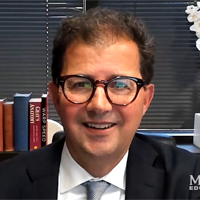
Cardiac MRI: Case Studies in Improving Patient Outcomes
A patient with severe dyspnea, a patient with potential heart block, and a young patient with chest pain. How does cardiac magnetic resonance imaging (CMR) answer the clinical question?
Authors: James C. Carr, MD; Kate Hanneman, MD, MPH, FRCPC; Raymond Y. Kwong, MD, MPH
Credit: 0.75 ARRT Category A CE Credit
Physician credit available at Medscape Education
Target Audience and Goal Statement
This activity is intended for radiologists, cardiologists, and radiologic technologists.
The goal of this activity is for learners to be better able to inform clinical decision making using CMR.
Upon completion of this activity, participants will:
- Have increased knowledge regarding the
- Clinical applications for CMR
- Techniques used for CMR to support clinical decision-making
- Demonstrate greater confidence in their ability to
- Inform clinical decision making using CMR
 Cardiac MRI Overview
Cardiac MRI Overview
Need a refresher on CMR basics? You’ve come to the right place.
James C. Carr, MD
 Assessing Chest Pain
Assessing Chest Pain
A 26-year-old male presents with chest pain. There is no evidence of coronary disease on computed tomography angiography (CTA). How can CMR help to diagnose this patient?
James C. Carr, MD
 Incidental Findings
Incidental Findings
A patient with heart block, a patient undergoing chemotherapy, and a patient on oral anti-cancer treatment. Expect the unexpected.
Kate Hanneman, MD, MPH, FRCPC
 Evaluating Dyspnea
Evaluating Dyspnea
A patient with severe dyspnea presents to the emergency room (ER). The chest computed tomography (CT) is negative for pulmonary embolism. How can CMR help to diagnose this patient?
Raymond Y. Kwong, MD, MPH
 The Clinical Value of Cardiac MRI
The Clinical Value of Cardiac MRI
Putting it all together with this brief summary.
Raymond Y. Kwong, MD, MPH
ACCREDITATION AND CREDIT
This activity has been approved by the American Society of Radiologic Technologists (ASRT) for 0.75 hours of ARRT Category A continuing education credit.
HOW TO RECEIVE PHYSICIAN CREDIT
- Enroll and participate on the Medscape Education website.
HOW TO RECEIVE ARRT CREDIT
- Log-in to your account at www.icpme.us
- Enroll in the course by clicking the Enroll Now button.
- View the entire educational activity session.
- At the conclusion of this lecture, close the Vimeo media window
- Return to the course in your account at www.icpme.us
- Access the POSTTEST and for EVALUATION by clicking on the appropriate icons located on the left sidebar.
- A passing grade of at least 75% is required to receive credit. You may take the test up to maximum of three times.
- Upon receipt of a passing grade, you will be able to print a certificate of credit from your account at www.icpme.us.
- A summary of credits earned is available by clicking on the TRANSCRIPT REPORT tab located in your account.
Faculty

James C. Carr, MD
Drs. Frederick John Bradd and William Kennedy Memorial Professor of Radiology
Chair, Department of Radiology
Northwestern University Feinberg School of Medicine
Chicago, Illinois, United States

Kate Hanneman, MD, MPH, FRCPC
Associate Professor of Radiology
University of Toronto
Director of Cardiac Imaging Research
University Medical Imaging Toronto
Toronto General Hospital
Toronto, Ontario, Canada

Raymond Y. Kwong, MD, MPH
Professor of Medicine
Harvard Medical School
Director, Cardiac Magnetic Resonance Imaging
Brigham and Women’s Hospital
Boston, Massachusetts, United States
Questions?
For questions regarding this program, please contact ICPME: information@icpmed.com
PROVIDED BY


 Shopping Cart: 0 Items
Shopping Cart: 0 Items